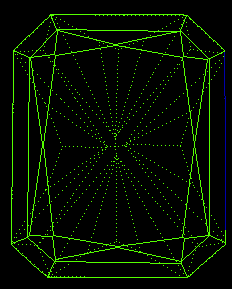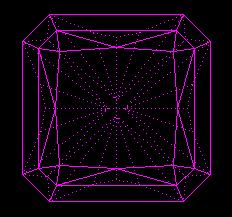|
July 14, 2006 - Helium Polish 1:1 version 3.80 (build 74) and Helium
Polish 1:2 version 3.80 (build 75) are released.
The features of new release:
- The Girdle Type parameters were substituted by new parameters:
Crown Painting and Pavilion Painting. They estimate crown and
pavilion independently. New parameters are added
to the reports for round brilliants.
- Improved building of fancy cutting and its semipolished.
- The mode of construction various cutting by ASCII
is included.
New parameters Crown painting
and Pavilion painting description
Following new parameters are added to the reports for brilliants:
Crown painting, degrees
Crown painting, notches
Crown painting, text
Crown painting type, text
Pavilion painting, degrees
Pavilion painting, notches
Pavilion painting, text
Pavilion painting type, text
Painting parameter defines deviation of halves' facet azimuths
from ideal. For each lower and upper facet software calculates difference
between azimuth of this facet and azimuth of the nearest main facet.
The ideal brilliant will always have this difference equal to 11.25
degrees. Real stone may have some deviations. So, deviation of this
difference from ideal 11.25 degrees is the (signed) value of the
"painting, degrees" parameter.
"painting, notches" is defined as following:
painting, notches = abs(painting,degrees)/3.75 <degrees>
It is the same deviation but unsigned and dimensionless.
Such deviations from ideal lead to changes in the girdle shape.
They may make girdle thinner or thicker.
There are text descriptions for these deviations besides numerical
values. The "painting, text" parameter may be one of the
following depending on the "painting,notches" (average)
value:
(0.0 - 0.1) Absent
(0.1 - 0.3) Very small
(0.3 - 0.8) Small
(0.8 - 1.2) Practical
(1.2 - 1.8) Big
(1.8 - 2.2) Very big
(2.2 - oo) Huge
There is one more text description of the whole girdle for crown
and pavilion sides: "Crown painting type" and "Pavilion
painting type". It may be one of the following: "Painting"
or "Digging" or empty. If painting parameter is rated
as "Absent", the "type" is empty. Otherwise
the "painting,degrees" (average) parameter is considered.
If it is less than 0, the type is "Painting", otherwise
it is "Digging".
Please see the examples of new reports:
Construction any cutting by
ASCII files
New mode allows constructing model of scanned diamond with any
cut. ASCII files uses as a sample.
There is the example of scanned model:
 |
| Result. Scanning model |
 Open 3D model*
of the scanned diamond Open 3D model*
of the scanned diamond
 |
| Sample model from
ASCII file |
 Open 3D
model of the sample diamond Open 3D
model of the sample diamond
*To open 3D models you need a free GemAdviser
software
Versions history
Helium news
|




















